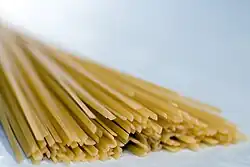Linguine
 | |
| Type | Pasta |
|---|---|
| Place of origin | Italy |
| Region or state | Liguria |
| Main ingredients | Flour (usually from durum wheat), egg |
| Variations | Linguettine |
Linguine (lit. 'little tongues'),[a] sometimes anglicized as linguini, is a type of pasta similar to fettuccine and trenette, distinguished by its elliptical rather than flat section. Around about 4 millimetres (5⁄32 in) in width, it is wider than spaghetti, but less wide than fettuccine.[2][3] Linguine was traditionally served with sauces such as pesto, but others such as tomato or fish based sauces are popular as well.[4]
Linguine originated in the city of Genoa and is based on more traditional pastas.[5]
Etymology
Linguine comes from the Latin word lingua, meaning 'tongue'. The modern language closest to Latin is Italian, and the Italian word linguine, plural of the feminine linguina, means 'little tongues'. A thinner version of linguine is called linguettine.[6]
History
Linguine, a type of flattened spaghetti, was initially documented in the 1700s in Genoa, Italy, by Giulio Giacchero, an economist and writer. Giacchero, author of a book on the economy of Genoa in the 1700s, wrote about linguine served with green beans, potatoes, and a Genovese specialty—basil pesto.[7] He claimed it was the typical festive dish of Ligurian families of the 1700s.[8]
Liguria is the coastal region in far northwest Italy on the Ligurian Sea, dominated by the ancient port of Genoa. Basil pesto is a traditional dish there, and is typically served over linguine.[9]
In the United States, National Linguine Day occurs on 15 September every year.[10]
Production
The production of linguine involves mixing semolina flour or durum flour and water to form a dough, which is then rolled out and cut into flat strands. This elongated shape is the primary way linguine and spaghetti are distinguished, the latter being round. Before the proliferation of modern production techniques, pasta-making was a labor-intensive process carried out by hand.[11]
Wheat can also be ground into whole-wheat flour, then kneaded with water to make whole grain linguine.[12]
Nutrition
| Nutritional value per 100 g (3.5 oz) | |||||||||||||||
|---|---|---|---|---|---|---|---|---|---|---|---|---|---|---|---|
| Energy | 433 kcal (1,810 kJ) | ||||||||||||||
58.9 g | |||||||||||||||
| Dietary fibre | 2.2 g | ||||||||||||||
17.8 g | |||||||||||||||
8.89 g | |||||||||||||||
| |||||||||||||||
| Other constituents | Quantity | ||||||||||||||
| Cholesterol | 11 mg | ||||||||||||||
Source: USDA[13] | |||||||||||||||
| †Percentages estimated using US recommendations for adults,[14] except for potassium, which is estimated based on expert recommendation from the National Academies[15] | |||||||||||||||
Linguine provides sources of energy, carbohydrates, fibers, fat, protein, and minerals.[13]
Preparation
Dry linguine is cooked in a pot of salted, boiling water. The linguine is stirred gently to prevent sticking together and cooked for 8–10 minutes or until al dente.
Linguine's flat shape provides a surface area for clinging to sauces, making it more common for seafood dishes.[16] This quality makes it the preferred type of pasta for seafood among Neapolitans.[17]
See also
![]() Media related to Linguine at Wikimedia Commons
Media related to Linguine at Wikimedia Commons
Notes
References
- ^ "Definition of LINGUINE". www.merriam-webster.com. Retrieved 2020-02-11.
- ^ "Fresh Pasta widths and serving sizes Lasagne sheets and Asian Noodles". www.cucinafoods.co.nz. Archived from the original on 2019-12-19. Retrieved 2020-02-11.
- ^ "CNN Food Central - Resources: Pasta Shapes and Sizes". www.cnn.com. Retrieved 2020-02-11.
- ^ "Linguine". Pasta Fits. 2018-08-24. Retrieved 2020-02-11.
- ^ "About Linguine". ifood.tv. Retrieved 2020-02-11.
- ^ "Linguine & Linguettine". www.ultimatecookingguide.com. Archived from the original on 2016-10-19. Retrieved 2020-02-11.
- ^ "Spotlight Series: All About Linguine". DeLallo. Retrieved 2024-04-13.
- ^ Tronson, Signe (2021-07-20). "A Little Linguini History". Pastini. Retrieved 2024-04-24.
- ^ Taste Pasta (PDF).
- ^ "NATIONAL DAY CALENDAR: National Linguine Day". KX NEWS. 2023-09-15. Retrieved 2024-04-26.
- ^ Marchetti, Domenica; Ruffenach, France (2011). "The Glorious Pasta of Italy". The Libraries Consortium. Retrieved 2024-04-26.
- ^ Clark, Melissa (2010-10-12). "Fiber Meets Flavor in New Whole-Grain Pastas". The New York Times. ISSN 0362-4331. Retrieved 2024-04-24.
- ^ a b "FoodData Central". fdc.nal.usda.gov. Retrieved 2024-04-25.
- ^ United States Food and Drug Administration (2024). "Daily Value on the Nutrition and Supplement Facts Labels". FDA. Archived from the original on 2024-03-27. Retrieved 2024-03-28.
- ^ "TABLE 4-7 Comparison of Potassium Adequate Intakes Established in This Report to Potassium Adequate Intakes Established in the 2005 DRI Report". p. 120. In: Stallings, Virginia A.; Harrison, Meghan; Oria, Maria, eds. (2019). "Potassium: Dietary Reference Intakes for Adequacy". Dietary Reference Intakes for Sodium and Potassium. pp. 101–124. doi:10.17226/25353. ISBN 978-0-309-48834-1. PMID 30844154. NCBI NBK545428.
- ^ ThriftBooks. "All Editions of 123 Seafood Linguine Recipes: Discover Seafood Linguine Cookbook NOW!". ThriftBooks. Retrieved 2024-04-26.
- ^ Schwartz, Arthur (1998). Naples at Table: Cooking in Campania. New York: HarperCollins. pp. 132. ISBN 0-06-018261-X.